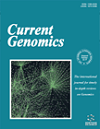- Home
- A-Z Publications
- Current Genomics
- Previous Issues
- Volume 2, Issue 4, 2001
Current Genomics - Volume 2, Issue 4, 2001
Volume 2, Issue 4, 2001
-
-
Helicase Domain Containing Proteins in Human Disorders
More LessAuthors: A.S. Balajee and C. ApRhysHelicases are enzymes that unwind DNA-DNA and RNA-DNA duplexes play important roles in many DNA metabolic activities like replication, transcription, recombination and repair. The molecular link between helicases and genomic stability has become stronger by recent studies indicating that the genes responsible for certain human degenerative disorders such as Werner syndrome (WS), Bloom syndrome (BS) a Read More
-
-
-
Comparative Genomic Hybridization: A Valuable Tool for Genome-Scale Analysis of Rodent Cancer Models
More LessAuthors: R. Kappler and H. ScherthanComparative genomic in situ hybridization (CGH) studies have marked regions of unbalanced genomic alterations in a variety of human solid and hematological malignancies. Subsequent molecular analysis helped to pinpoint genes contributing to tumorigenic development and progression. CGH has since become a routine tool in molecular diagnostics and cancer research. Since mice and rats represent major model systems Read More
-
-
-
SNARE Proteins - From Membranes to Genomes
More LessBy M. LinialThe function and the organization of eukaryotic cells require directional transport of vesicles between compartments. This sort of membrane flow relies on the presence of docking and fusion machinery. The core of this machinery is a protein complex composed of syntaxin, SNAP-25 and VAMP, collectively termed SNAREs. A correct interaction among SNARE prototypes is essential for fruitful docking and fusion. Analysis of large-s Read More
-
-
-
Mitochondrial Contributions to Aging in the Nematode Caenorhabditis elegans
More LessAuthors: N. Ishii, K. Kita and P.S. HartmanFree radicals and their sequelae figure prominently in cellular and organismal aging. Generated primarily in mitochondria as unwanted products of oxidative phosphorylation, free radicals induce a wide variety of damage that compromises molecular, cellular and organismal integrity. The free-living nematode Caenorhabditis elegans has been employed widely to explore the genetics of aging. One extremely successful approach Read More
-
-
-
Turner Syndrome : How Is It Made Up?
More LessBy T. OgataTurner syndrome is a well defined sex chromosomal disorder characterized by short stature, characteristic somatic stigmata, and gonadal dysgenesis. In this review, I summarize recent progress in the clarification of genetic mechanisms involved in the development of clinical features. The essence is as follows: (1) Short stature is primarily ascribed to loss of SHOX cloned from the short arm pseudoautosomal region and Read More
-
-
-
Transcriptional Regulation in Mammalian Pituitary Development and Disease
More LessAuthors: K.W. Sloop, G.E. Parker and S.J. RhodesThe pituitary gland is a complex endocrine organ secreting hormones that regulate a wide array of vertebrate physiological processes, including growth, lactation, metabolic homeostasis, reproduction, water balance, and the stress response. In the mature organ, specialized cells that have a common origin in the early ectoderm release their characteristic products into the bloodstream. Together, the embryological processes Read More
-
-
-
Micro Arrays and Biochips: Applications and Potential in Genomics and Proteomics
More LessAuthors: T. Vo-Dinh and M. AskariThis report provides an overview of the development and applications of DNA-based microarrays and biochip technology in genomics. DNA microarrays and biochip technologies are having a significant impact on a wide variety of areas in genomic research. Many fields, including gene discovery, drug discovery, toxicological research, and medical diagnostics, will benefit from the use of DNA micro array and biochip tech Read More
-
Volumes & issues
-
Volume 26 (2025)
-
Volume 25 (2024)
-
Volume 24 (2023)
-
Volume 23 (2022)
-
Volume 22 (2021)
-
Volume 21 (2020)
-
Volume 20 (2019)
-
Volume 19 (2018)
-
Volume 18 (2017)
-
Volume 17 (2016)
-
Volume 16 (2015)
-
Volume 15 (2014)
-
Volume 14 (2013)
-
Volume 13 (2012)
-
Volume 12 (2011)
-
Volume 11 (2010)
-
Volume 10 (2009)
-
Volume 9 (2008)
-
Volume 8 (2007)
-
Volume 7 (2006)
-
Volume 6 (2005)
-
Volume 5 (2004)
-
Volume 4 (2003)
-
Volume 3 (2002)
-
Volume 2 (2001)
-
Volume 1 (2000)
Most Read This Month
Article
content/journals/cg
Journal
10
5
false
en


